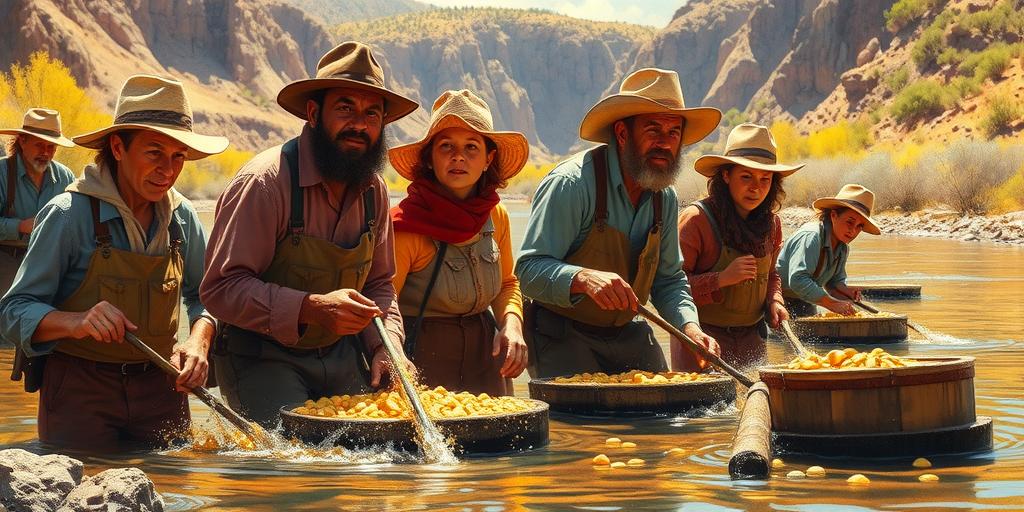Did you know that there was a time when virtually anyone could participate in mining? It’s true! Before the advent of massive corporations and complex machinery, the image of a lone prospector panning for gold was far more common than the vast industrial operations we see today. Let’s dig into the fascinating early days of mining, a time of rugged individualism and high-stakes risks. Prepare to be amazed by the stories of ordinary people striking it rich – and the many more who faced hardship and disappointment. This is a journey into the heart of a bygone era when the dream of striking it rich was within reach for nearly everyone.
The Gold Rush Era: A Frontier of Opportunity
The California Gold Rush of 1849 is perhaps the most iconic example of early mining’s accessibility. News of gold discoveries sparked a mass migration, transforming the landscape and attracting people from all walks of life – farmers, shopkeepers, doctors, even preachers, all traded their established lives for a chance at fortune. This period represents a golden age (pun intended!) of individual mining participation, fueled by rumors, grit, and the unwavering belief in a better life. Stories of overnight riches spread like wildfire, encouraging countless individuals to embark on this challenging journey. Many flocked to California, hoping to strike it rich and make a fortune. Think about it: the potential for individual success was enormous. The simple tools required, like pans and picks, were relatively inexpensive, lowering the barrier to entry for hopeful miners. This is a far cry from the heavily regulated and technologically advanced mining operations of the modern day. Many long-tail keywords, such as “California Gold Rush individual mining stories”, “1849 Gold Rush personal accounts”, and “early mining equipment and techniques”, shed light on this exciting historical period.
The Tools of the Trade: Simple Beginnings
Early mining techniques were, by today’s standards, remarkably simple. The tools of the trade were basic: picks, shovels, pans, and sluice boxes. These rudimentary tools didn’t require specialized training or significant investment, making mining accessible to nearly anyone. Prospectors would search for promising veins of ore, using simple methods to extract the valuable minerals. The sheer number of ordinary individuals who ventured into mining during this era, armed with only these basic tools, showcases the accessibility of mining during its early stages. This period also saw the emergence of individual mining claims, which further solidified the participation of individuals in the mining industry. Keywords like “basic mining tools”, “early mining techniques”, and “individual mining claims” help us understand the simplicity and direct participation of individuals.
Beyond Gold: Other Precious Resources and Opportunities
While gold is often associated with early mining, people also sought various other minerals and resources. Silver, copper, coal, and even gemstones all attracted individuals hoping to strike it rich. The methods varied depending on the resource, but the common thread was the relative ease of participation for independent prospectors and miners. The discovery of these varied resources extended the opportunities available to individual miners, creating a more diversified landscape of exploration and wealth creation. Long-tail keywords such as “early silver mining techniques”, “individual coal mining history”, and “historical gemstone prospecting” can further illuminate these early mining activities.
The Rise and Fall of Individual Mining
As technology advanced, the landscape of mining changed drastically. The increased complexity of operations, the need for large-scale investments and specialized equipment, and stricter regulations made it increasingly challenging for individuals to compete with large corporations. The transition from individual mining to large-scale industrial operations represented a significant shift in the accessibility and economic opportunities related to the industry. This shift can be analyzed using long-tail keywords like “transition from individual to industrial mining”, “impact of technology on early mining”, and “mining regulations and individual miners”.
The Legacy of Early Mining: A Romantic Notion?
While the romantic image of the lone prospector is often emphasized, it’s vital to remember the harsh realities faced by many early miners. The work was backbreaking, the risks were high, and the rewards were far from guaranteed for many. Disease, accidents, and financial ruin were all common occurrences. However, the legacy of early mining lies in the opportunity it provided to ordinary people to improve their lives, however risky it may have been. It was a testament to the human spirit, the desire to improve one’s circumstances, and the allure of the dream of riches and independence.
A Lasting Impact
The early days of mining left an indelible mark on society and culture. Stories of triumph and tragedy continue to fascinate, reminding us of the risks and rewards that have shaped our world. The era inspired countless tales, legends, and cultural representations, establishing a rich heritage that continues to influence our understanding of frontier exploration, resource exploitation, and the American dream. Long-tail keywords such as “the cultural impact of early mining”, “early mining legends and stories”, and “the American Dream and early mining” provide further insights into this rich cultural legacy.
Want to learn more about this fascinating period in history? Dive deeper into the annals of early mining and uncover the untold stories of those who dared to dream of gold! Click here to access our extensive collection of historical mining records and resources!




